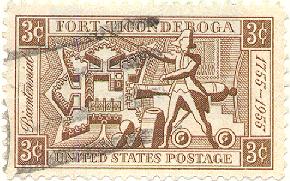Battle of Ticonderoga (1777)
|
|
For other battles at Fort Ticonderoga, see Battle of Ticonderoga.
| The Battle of Ticonderoga (1777) | |||||||||||||||||
|---|---|---|---|---|---|---|---|---|---|---|---|---|---|---|---|---|---|
| Conflict | American Revolutionary War | ||||||||||||||||
| Date | July 5-July 6, 1776 | ||||||||||||||||
| Place | Fort Ticonderoga, Lake Champlain, New York | ||||||||||||||||
| Result | Decisive British victory | ||||||||||||||||
| |||||||||||||||||
The Battle of Ticonderoga on July 5 and July 6, 1777 was more a battle of maneuver than a direct conflict in the American Revolutionary War. The British army, led by John Burgoyne, occupied the fort after forcing American General Arthur St. Clair to withdraw the defenders.
| Contents |
Background
The British and Hessian advance of the previous summer was halted at the Battle of Valcour, but everyone knew they would return, as Fort Ticonderoga was a key strongpoint controlling the southern extent of Lake Champlain and thus entry to the Hudson River Valley, making it a key location in the British strategy to divide the rebellious colonies in two by linking British forces moving south from Quebec with those moving northward along the Hudson from New York City.
Winter fortifications
Since the British withdrawal of the previous winter (see: Battle of Valcour Island) American forces had worked for months in defensive preparations to repair the old fort, and had built several new blockhouses. They also strengthened Fort Independence across Lake Champlain and had constructed a pontoon bridge where the La Chute River entered to support communication between the two.
The fort was manned by several under-strength regiments of the Continental Army and militia units from several states. In all, General Arthur St. Clair had about 2,500 men in the area.
Geography
A height called Sugar Loaf overlooked both forts, and large cannon on that height would make their positions impossible to defend; a tactical problem that John Trumbull had pointed out earlier in the year when General Gates had been in command.
Gates felt it was impossible for the British to place cannon on the heights, and after Gates left to lobby the Congress, his successor General Schuyler also declared that the concern was pointless.
With Gates and Schuyler locked in a political struggle for command of the Northern Department, and General St. Clair was left in command, he refused to override Schuyler's orders, holding to his position even after Tadeusz Kosciuszko repeated Trumbull's warning and Benedict Arnold, with his bad leg, climbed to the top of Sugar Loaf to confirm the reality of the threat. Since Gates now endorsed Kosciusko's advice, Schuyler and St. Clair ignored it.
British strength
Burgoyne's force of around 8,000 men with artillery and naval support was enough to overwhelm St. Clair's position, manned by about 3,500 includeing newly-arrived militia. Schuyler ordered St. Clair to hold out as long as he could before withdrawing, while additional forces were gathered for the defense of Albany. By early July, the Burgoyne expedition arrived in the area.
Evacuation and fall
British reconnaissance also discovered the strategic position of Sugar Loaf. Starting on July 2 they cleared and fortified gun emplacements on top of that height. They also spent several days drawing some of their larger guns up the slope, using winches to move from tree to tree. On July 4 the Americans held a quiet celebration with some toasts to commemorate the previous year's Declaration of Independence, but on the morning of July 5, 1777 they awoke to discover the completed British position, with more guns arriving throughout the day.
Trumbull had already demonstrated that fire from the American guns couldn't reach the summit, and aware that devastating fire from the heights would reduce the fortress to rubble, General St. Clair withdrew his force under cover of darkness on July 5.
The guns at Ticonderoga, most remaining supplies, and some men too ill and wounded to move were left to the British. A handful of men were left at Fort Independence with loaded cannon and lit matches to fire on the pontoon bridge after the withdrawal, but after indulging in some of the remaining supplies, notably, a barrel of wine, they were incapable of military action. The next morning, British troops captured them and occupied the forts without firing a shot. General Simon Fraser set out in pursuit of the retreating Americans.
Aftermath
The withdrawal from Ticonderoga was hurried, but was a part of the American defensive strategy adopted by General Schuyler in response to the British Saratoga Campaign. Fraser's pursuit resulted in the Battle of Hubbardton as they caught up with the rear guard. St. Clair, meanwhile, brought most of his men to join forces with Schuyler at Fort Edward, and prepare for the Battle of Saratoga. Ticonderoga did not substantially delay Burgoyne's advance, but he did leave several regiments and much of his Canadian force as a garrison.
The political impact of the surrender was much stronger. Congress was appalled, and they censured both Schuyler and St. Clair for the loss. Schuyler was removed as commander of the Northern Department and replaced with General Horatio Gates. Arthur St. Clair maintained that his conduct had been honorable, demanded review by a Court martial, and was completely exonerated.
Eventually, after Burgoyne's surrender at the Battle of Saratoga, the British Forces in withdrew to St. John's, and the Americans re-occuped Fort Ticonderoga with no major incidents.de:Schlacht von Ticonderoga (1777)

